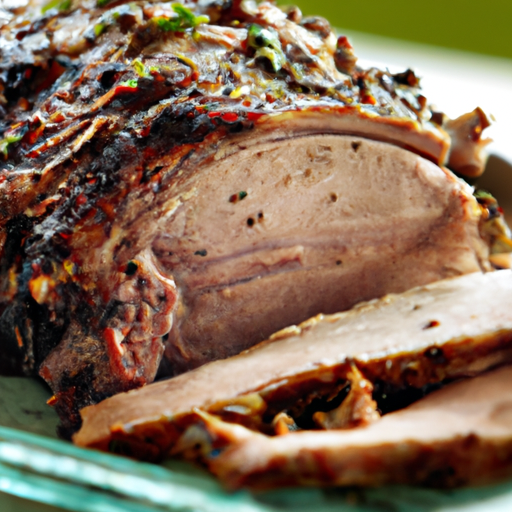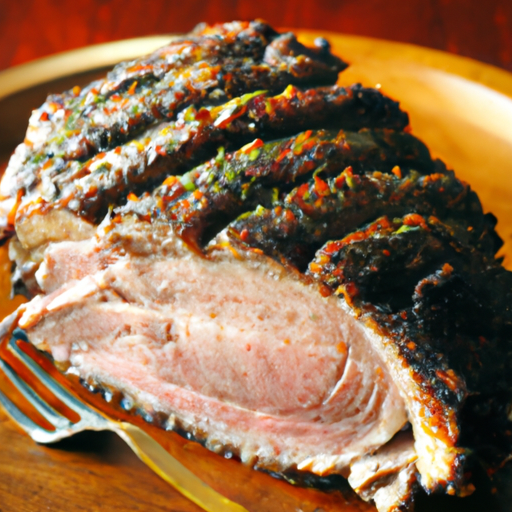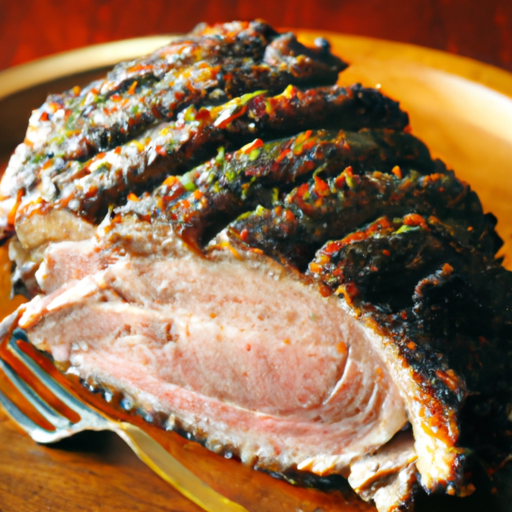Are you ready to impress your guests with a mouthwatering centerpiece for your next dinner party? Look no further than the Savory Rib Roast Recipe. This delectable dish is sure to be the star of any meal, with its perfectly seasoned flavors and tender, juicy meat. Whether you’re a novice cook or a seasoned pro, this recipe is easy to follow and yields impressive results. Get ready to savor every delicious bite of this show-stopping rib roast, as it becomes the highlight of your dining experience.

Savory Rib Roast Recipe
Welcome to this friendly guide on how to make a delicious and savory rib roast! Whether you’re celebrating a special occasion or simply treating yourself, this recipe is sure to impress. Follow along as we walk you through each step, from selecting the perfect rib roast to serving it up with tasty accompaniments.
Ingredients
To create this mouthwatering dish, you’ll need the following ingredients:
- Rib Roast (bone-in): The star of the show, this cut of beef is known for its superb flavor and tenderness.
- Salt: Enhances the natural flavors of the meat.
- Ground black pepper: Adds a subtle kick of heat and complements the beef’s richness.
- Garlic powder: Infuses the roast with a delightful, aromatic flavor.
- Onion powder: Adds a savory depth to the seasoning.
- Dried thyme: Brings a hint of earthiness to the dish.
- Dried rosemary: Imparts a fragrant and pine-like taste.
- Olive oil: Helps to seal in moisture and adds a touch of richness.

Preparing the Rib Roast
Selecting the Rib Roast
When purchasing your rib roast, it is important to choose one that has a good amount of marbling, or fat running through the meat, as this will contribute to its tenderness and flavor. Look for a roast that has a bright red color and firm texture. A bone-in rib roast can add extra flavor and help to keep the meat moist during cooking.
Trimming the Fat
Before seasoning and cooking the rib roast, it’s a good idea to trim excess fat from the surface. Leaving a thin layer of fat can enhance the flavor, but too much can cause excessive grease. Use a sharp knife to carefully remove any thick or loose pieces of fat, while being mindful not to remove too much of the marbling.
Bringing the Roast to Room Temperature
To ensure even cooking and a tender end result, let the rib roast sit at room temperature for about 1-2 hours before cooking. This allows the meat to relax and ensures that the inside cooks evenly, while the outside develops a delicious crust.
Seasoning the Roast
Creating the Spice Rub
Now it’s time to create a flavorful spice rub for your rib roast. In a small bowl, combine salt, ground black pepper, garlic powder, onion powder, dried thyme, and dried rosemary. Mix these ingredients together well to ensure that the seasoning is evenly distributed.
Applying the Spice Rub to the Roast
Generously rub the spice mixture all over the surface of the rib roast, making sure to coat it completely. Take your time to massage the seasoning into the meat, ensuring that it adheres well. This process will infuse the roast with incredible flavors during the cooking process.
Allowing the Roast to Marinate
After applying the spice rub, let the rib roast sit for at least 30 minutes or up to overnight in the refrigerator. This allows the flavors to penetrate the meat more deeply and gives the roast time to rest before it enters the hot oven.
Cooking the Roast
Preheating the Oven
Before cooking the rib roast, preheat your oven to a high temperature, typically around 450°F (230°C). This high initial heat will help to sear the outside of the roast, sealing in the juices and creating a delectable crust.
Roasting at High Temperature
Place the seasoned rib roast on a rack in a roasting pan and transfer it to the preheated oven. Allow the roast to cook at the high temperature for about 15 minutes. This initial sear will help to develop a beautiful brown crust on the outside of the meat.
Reducing the Temperature
After the initial searing, reduce the oven temperature to around 325°F (165°C). This lower temperature allows the heat to penetrate the center of the roast more gently, ensuring a tender and juicy result.
Monitoring the Internal Temperature
To achieve the desired level of doneness, it is important to monitor the internal temperature of the roast using a meat thermometer. Insert the thermometer into the thickest part of the roast, being careful not to touch the bone. For a medium-rare roast, aim for an internal temperature of 135°F (57°C), while a medium roast should reach around 145°F (63°C). Keep in mind that the internal temperature will continue to rise as the roast rests.
Determining the Cooking Time
The cooking time for a rib roast depends on various factors such as the size of the roast and your desired level of doneness. As a general guideline, plan for about 15-20 minutes of cooking time per pound of meat. However, it is always best to rely on the internal temperature as a more accurate indicator of doneness.
Basting the Roast
While the rib roast is cooking, you can enhance its succulence by basting it with the drippings from the pan. Use a baster or a spoon to drizzle the pan juices over the roast every 30 minutes or so. Basting adds moisture and intensifies the flavors, resulting in a more delicious end result.
Final Temperature for Desired Doneness
Once the roast reaches your desired internal temperature, remove it from the oven and tent it loosely with aluminum foil. Allow the roast to rest for at least 15-20 minutes before carving. During this resting period, the juices will redistribute and the temperature will continue to rise slightly, resulting in a more tender and flavorful roast.
Resting and Carving
Resting the Roast
Resting the rib roast is a crucial step to allow the meat to relax and retain its juices. After removing the roast from the oven, cover it loosely with foil and let it rest for 15-20 minutes. This resting period allows the juices to redistribute evenly throughout the meat, resulting in a more succulent and delicious roast.
Carving Techniques
When it comes to carving your perfectly cooked rib roast, there are a few key techniques to keep in mind. Firstly, use a sharp carving knife to ensure clean cuts through the meat. Slice the roast against the grain, which helps to maximize tenderness. Cut thick or thin slices, depending on your preferences, and arrange them on a platter for serving.
Removing the Bones (if desired)
If you prefer boneless slices or want to save the bones for other uses, you can easily remove them from the rib roast. After resting the roast, carefully cut through the meat along the bone to separate it from the roast. Slice the meat into desired portions and enjoy the delicious boneless slices.
Serving Suggestions
Accompaniments
A savory rib roast pairs beautifully with a range of accompaniments. Serve it alongside creamy horseradish sauce for a tangy kick, or indulge in a decadent red wine jus for added richness. Don’t forget to include some freshly baked dinner rolls or crusty bread on the side, perfect for soaking up those delicious meaty flavors.
Side Dishes
To complete your rib roast feast, consider serving an array of delectable side dishes. Classic options include garlic mashed potatoes, roasted vegetables, or creamy spinach gratin. Other great choices include Yorkshire puddings, green bean casserole, or honey-glazed carrots. These flavorful sides will complement the richness of the rib roast and create a well-rounded meal.
Sauces and Gravies
For an extra layer of flavor, consider serving some tangy or savory sauces and gravies alongside your rib roast. Creamy horseradish sauce, red wine reduction, or a rich beef jus all make excellent choices. These condiments can be used to enhance the flavors of both the meat and the accompaniments, adding a touch of indulgence to your meal.
With this comprehensive guide, you now have all the information you need to make a savory rib roast that will impress your family and friends. From selecting the perfect cut to seasoning, cooking, and serving, each step is designed to give you a delicious and memorable dining experience. So, tie on your apron, gather your ingredients, and get ready to savor the mouthwatering flavors of a perfectly cooked rib roast. Happy cooking!
